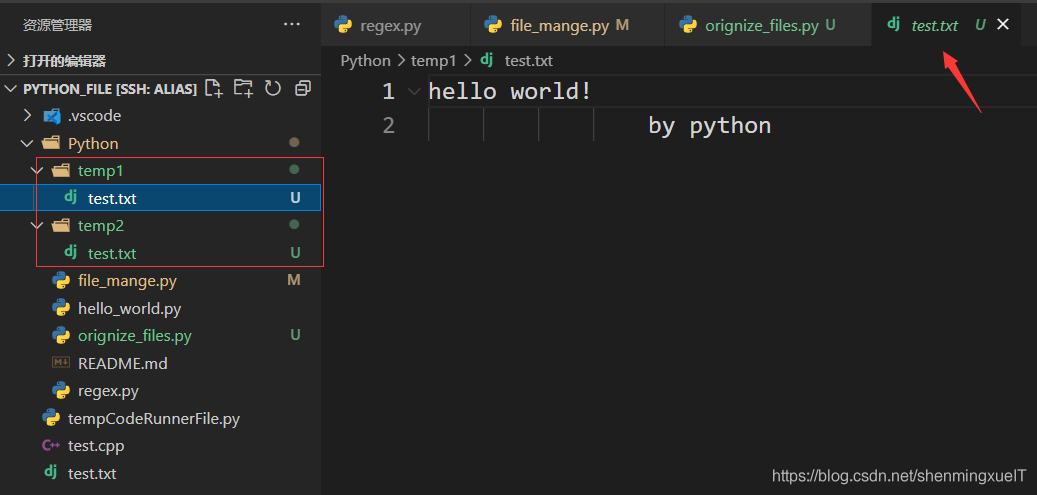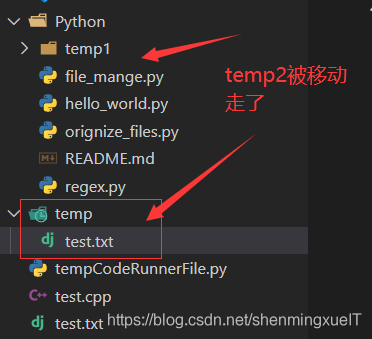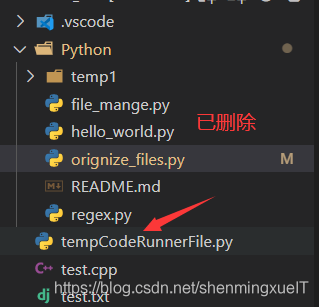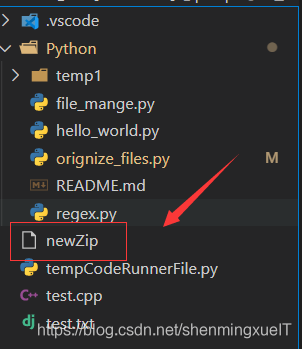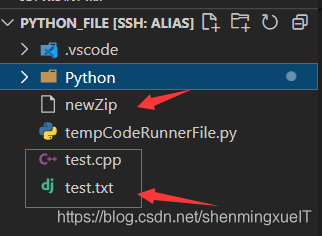热门文章
- Bootstrap安装教程 (发布时间:2021-06-25 17:03:51)
- bootstrap框架怎么用?10分钟教你学会使用bootstrap开发网页 (发布时间:2021-06-25 16:32:17)
- Bootstrap5 出来了,我应该学习Bootstrap4还是Bootstrap5? (发布时间:2021-05-02 13:21:53)
最新文章
- 我通过重新学习 HTML 学到的东西 (发布时间:2021-06-30 17:37:25)
- 设计师:注意你的语言 (发布时间:2021-06-30 17:28:00)
- 设计全方位搜索 (发布时间:2021-06-30 17:12:41)
- CSS 垂直媒体查询的用例 (发布时间:2021-06-30 17:05:47)
- 世界上最受欢迎的排版博客现在有一家商店 (发布时间:2021-06-30 17:05:31)
- 每天学习前端 Web 开发的旅程 (发布时间:2021-06-30 16:31:02)
- Bootstrap安装教程 (发布时间:2021-06-25 17:03:51)
- bootstrap框架怎么用?10分钟教你学会使用bootstrap开发网页 (发布时间:2021-06-25 16:32:17)
- 2021年世界上制造业网站设计的 5 个最佳范例 (发布时间:2021-06-22 15:29:54)
- CMS 的兴起和“网站管理员”的衰落 (发布时间:2021-06-22 15:26:45)
python基础学习之文件操作大全
发布时间:2021-06-22 15:26:45
一、Shutil 模块
shutil其实也就是shell模块。其中包含一些函数,可以让我们在python程序中复制、移动、改名和删除文件。
1.1 复制文件和文件夹
shutil.copy(source,destination):将路径source处的文件复制到路径destination处的文件夹。如果destination是一个文件名,那么它将作为被复制的新名字
shutil.copytree(source,destination):将路径source处的文件夹,包括它的所有文件和子文件夹,复制到路径destination处的文件夹。
结果:
1.2 移动文件和文件夹
shutil.move(source,destination):将source处的文件夹移动到路径destination,并返回新位置的绝对路径的字符串
注:
如果destination指向一个文件夹,source文件将移动到destination中,并保持原来的文件名;
如果destination指向一个文件,这个文件就会被覆盖,注意!
如果destination指向一个不存在的文件夹,这个时候source里面的内容会移动到destination,source改名为destination
结果:
1.3 删除文件和文件夹
os.unlink(path):将删除path处的文件
os.rmdir(path):将删除path处的文件夹。该文件夹必须为空,其中没有任何文件和文件夹
shutil.retree(path):将删除path处的文件夹,它包含的所有文件和文件夹都会被删除
结果:
二、遍历文件
os.walk(path):通过传入一个路径
os.walk()在循环的每次迭代中,返回三个值:
1.当前文件夹名称的字符串
2.当前文件夹中子文件夹的字符串的列表
3.当前文件夹中文件的字符串的列表
输出(部分):
ubuntu@VM-0-2-ubuntu:~/python_file$ /usr/bin/python3 /home/ubuntu/python_file/Python/orignize_files.py
/home/ubuntu/python_file:
/home/ubuntu/python_file: .vscode(dir)
/home/ubuntu/python_file: Python(dir)
/home/ubuntu/python_file: test.cpp
/home/ubuntu/python_file: test.txt
/home/ubuntu/python_file: tempCodeRunnerFile.py
/home/ubuntu/python_file/.vscode:
/home/ubuntu/python_file/.vscode: db(dir)
/home/ubuntu/python_file/.vscode: .git(dir)
/home/ubuntu/python_file/.vscode: log(dir)
/home/ubuntu/python_file/.vscode: settings.json
/home/ubuntu/python_file/.vscode/db:
/home/ubuntu/python_file/.vscode/db: cpptips.db-wal
/home/ubuntu/python_file/.vscode/db: cpptips.db-shm
/home/ubuntu/python_file/.vscode/db: cpptips.db
/home/ubuntu/python_file/.vscode/.git:
/home/ubuntu/python_file/.vscode/.git: 6eb7a60f73d1a1d9bdf44f2e86d7f4cc_test.cpp
/home/ubuntu/python_file/.vscode/log:
/home/ubuntu/python_file/.vscode/log: cpptips.server.2021-05-19.log
/home/ubuntu/python_file/.vscode/log: cpptips.server.2021-05-16.log
/home/ubuntu/python_file/.vscode/log: cpptips.server.2021-05-17.log
/home/ubuntu/python_file/.vscode/log: cpptips.client.log
/home/ubuntu/python_file/.vscode/log: cpptips.server.log
/home/ubuntu/python_file/Python:
/home/ubuntu/python_file/Python: temp1(dir)
/home/ubuntu/python_file/Python: .git(dir)
/home/ubuntu/python_file/Python: README.md
/home/ubuntu/python_file/Python: hello_world.py
/home/ubuntu/python_file/Python: orignize_files.py
/home/ubuntu/python_file/Python: regex.py
/home/ubuntu/python_file/Python: file_mange.py
.........
.........
.........
三、压缩文件
利用zipfile模块中的函数,python程序可以创建和打开ZIP文件。
3.1 创建和添加ZIP文件
想要创建ZIP文件,必须用ZipFile方法创建一个ZipFile对象。ZipFile对象在概念上和File对象相似。
之后,以写模式打开这个对象。调用write()方法传入一个路径,python就会压缩该路径所指的文件,将它加到ZIP文件中。write的第一个参数是一个字符串,代表要添加的文件名。第二个参数是”压缩类型“参数,告诉计算机使用怎样的算法来压缩文件。一般来说,ZIP_DEFLATED就可以了。
结果:
3.2 读取ZIP文件
当用ZipFile函数打开一个zip文件的时候,会返回一个ZipFile对象。之后调用这个对象的namelist()方法就可以获得zip里面的压缩文件列表。
同时这个对象还有一个getinfo()方法,通过传入一个压缩文件名,就可以获得这个文件的一些信息。
输出:
ubuntu@VM-0-2-ubuntu:~/python_file$ /usr/bin/python3 /home/ubuntu/python_file/Python/orignize_files.py
filename: test.txt
size: 26
compress_size: 26
filename: test.cpp
size: 30
compress_size: 28
3.3 解压缩ZIP文件
ZipFile对象的extractall方法从ZIP文件中解压缩所有的文件和文件夹,放到当前工作目录下:
结果:
四、参考文献
到此这篇关于python基础学习之组织文件的文章就介绍到这了
